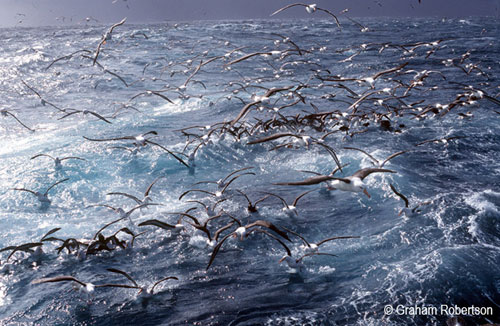Jaime Ojeda (Departamento de Ciencias y Recursos Naturales, Universidad de Magallanes, Punta Arenas, Chile) and colleagues writing in Spanish in the journal Revista de Biología Marina y Oceanografía have looked at which seabird species are associated with artisanal longlining in southern Chile.
The paper's English abstract follows:
"The fjords and channels of southern Chile represent breeding and feeding areas for sub-Antarctic seabird species. In addition, in these environments, an important artisanal austral hake Merluccius Australis longline fishery operates. Studies on the relationship between seabirds and this activity are fundamental for the ecology and conservation biology of these birds. This study examined the composition and structure of the seasonal seabird assemblages attending the artisanal longline fishing activities in channels of the Southeast Pacific, Chile. Fieldwork was carried-out during summer (Cook Bay), winter (Felix Lighthouse), and spring (Gulf Xaultegua) of 2008. Ten species were associated with fishing activities. The most common seabird species observed during the year were the Black-browed albatross Thalassarche melanophrys and the Southern giant-petrel Macronectes giganteus. The seasonal structure of the assemblages presented differences between summer and winter. In terms of abundance, Black-browed albatrosses presented the highest contribution to the assemblage in summer (87.5%). During winter the Kelp gull Larus dominicanus showed the highest contribution (47.7%) while the Black-browed albatross abundance decreased to 9.1%. Black-browed albatross was the species with the highest index of relative importance within the assemblies, but is also a species with the conservation status ‘endangered'. Therefore, it is necessary to maintain constant monitoring of the interaction between seabirds and artisanal longline fishing activities of sub-Antarctic environments.

Black-browed Albatrosses congregate behind a fishing vessel
Photograph by Graham Robertson
Reference:
Jaime Ojeda, J., Suazo, C.G. & Rau, J.R. 2011. Ensamble estacional de aves marinas en la pesquería del palangre artesanal de la merluza austral Merluccius australis, en canales subantárticos de Chile [Seasonal seabird assemblages in the artisanal long-line fishery of austral hake Merluccius australis, in Chile´s sub-Antarctic channels]. Revista de Biología Marina y Oceanografía 463: 443-451.
John Cooper, ACAP Information Officer, 4 February 2012

 English
English  Français
Français  Español
Español